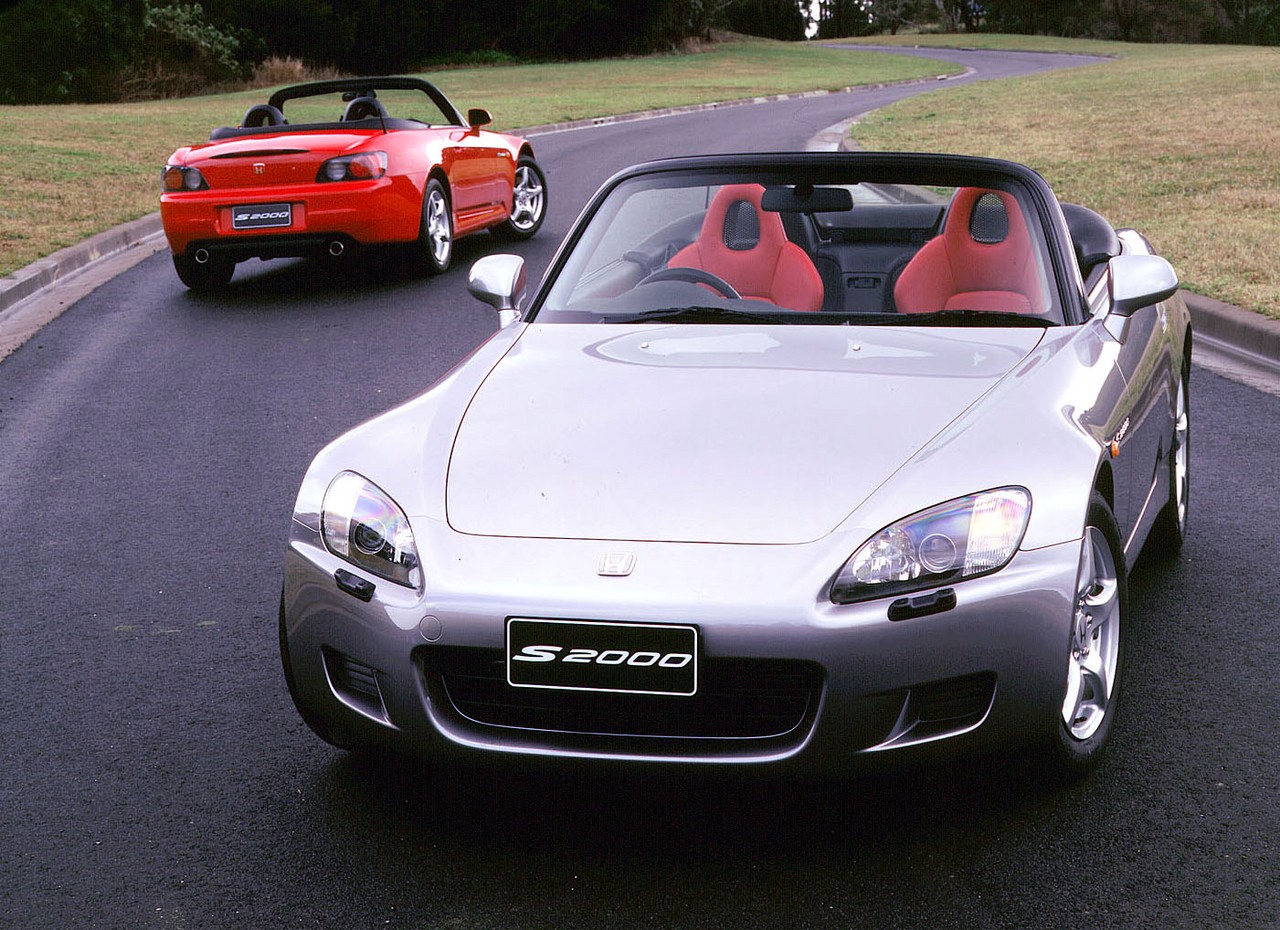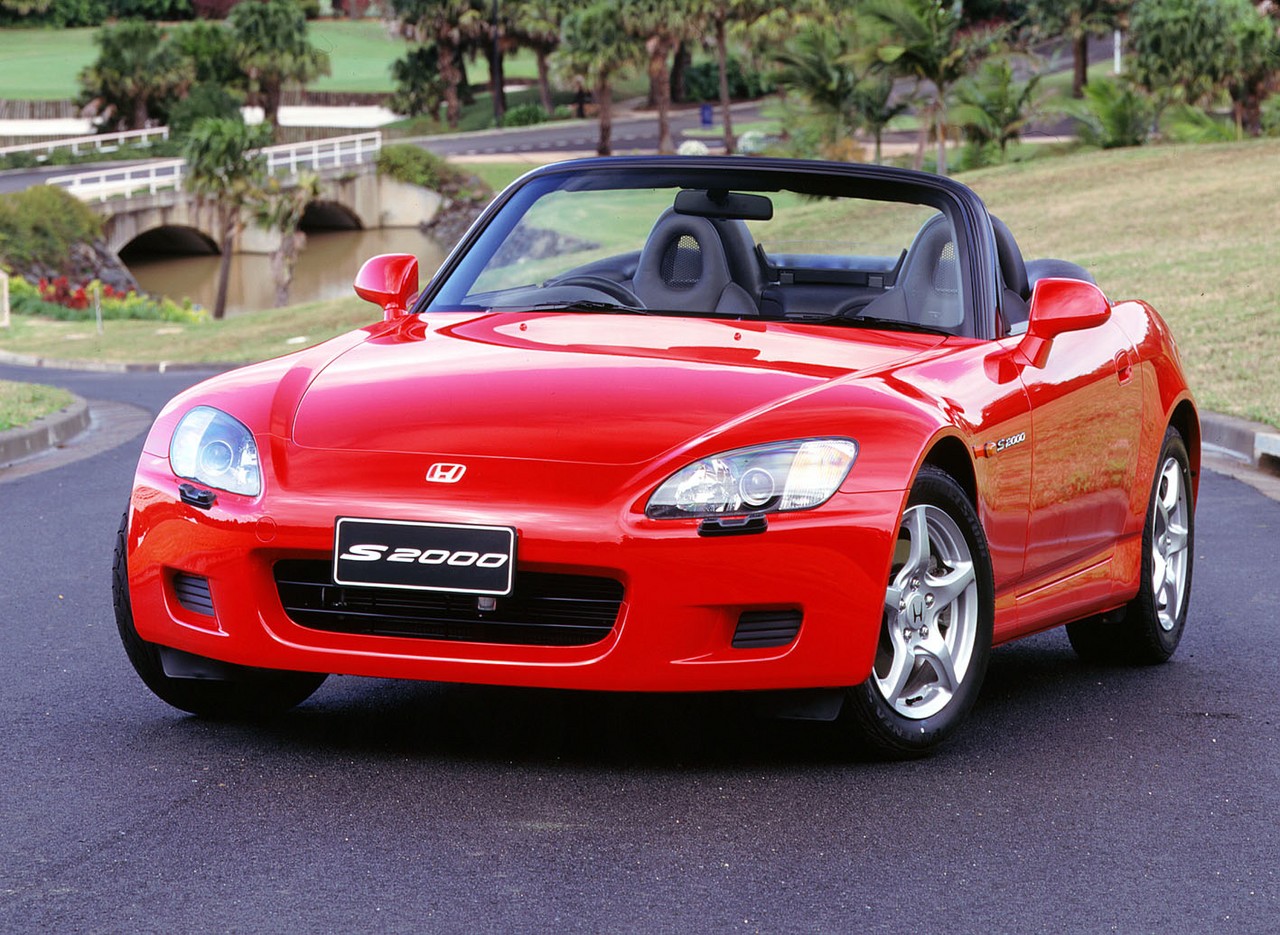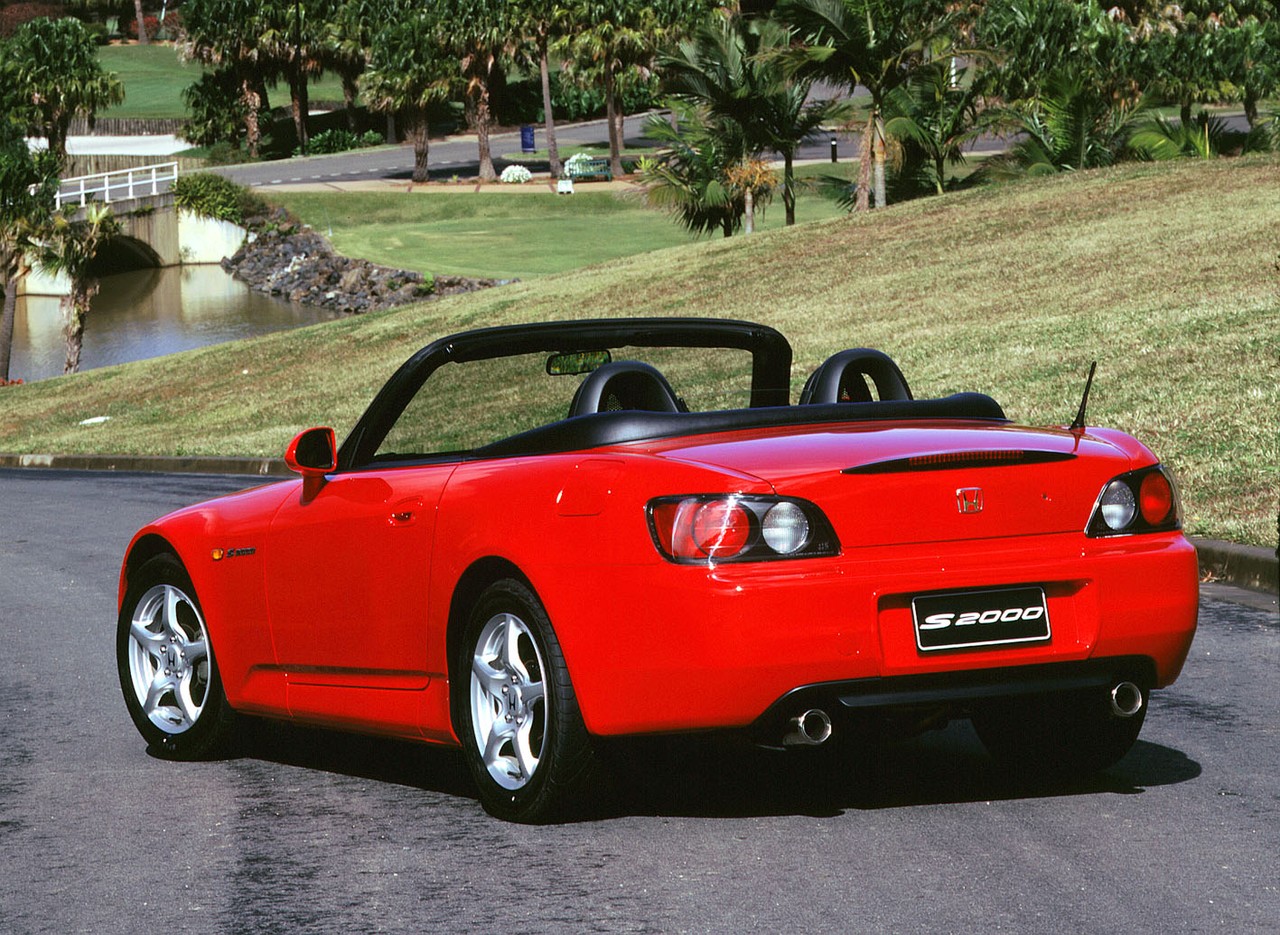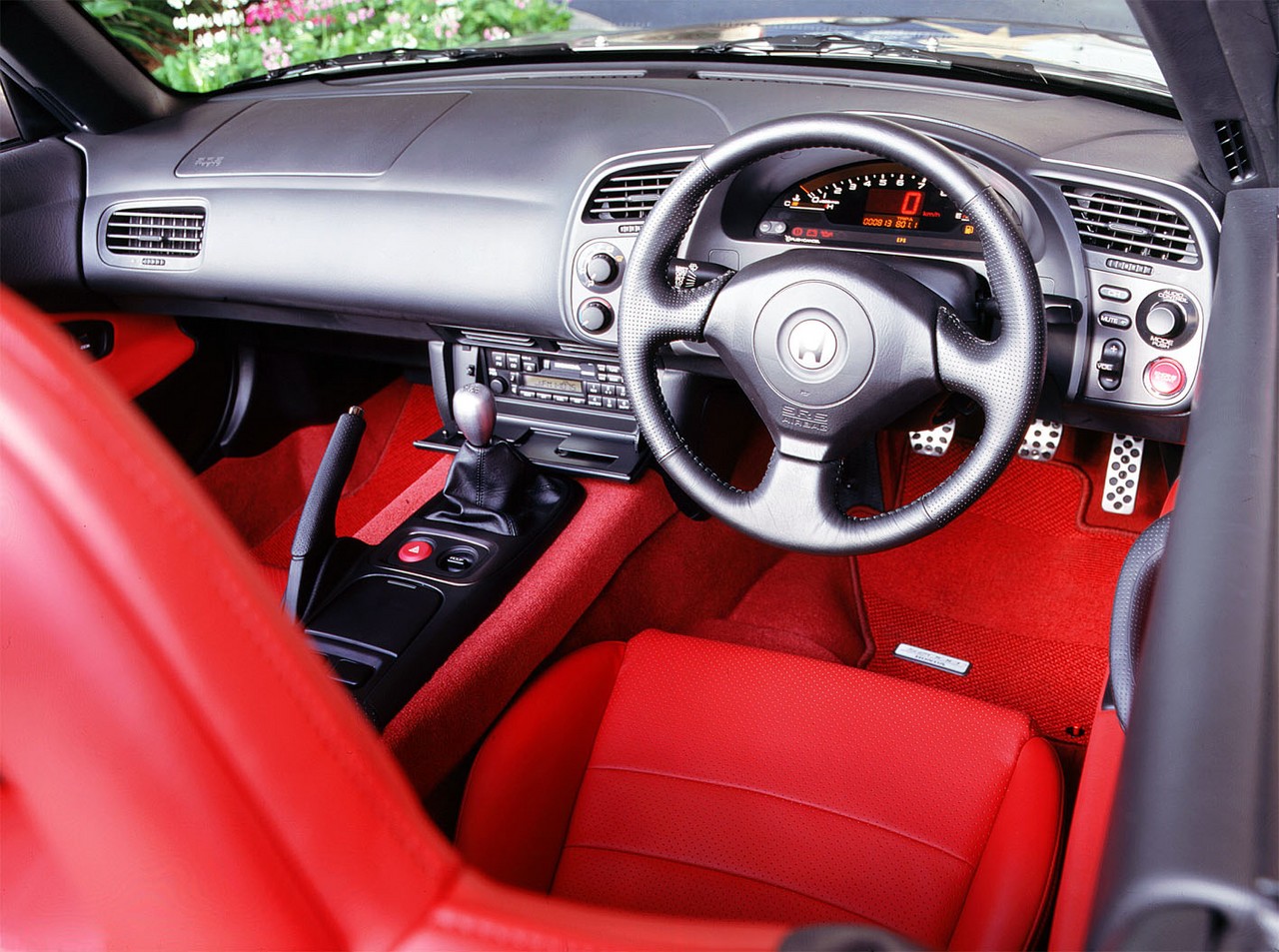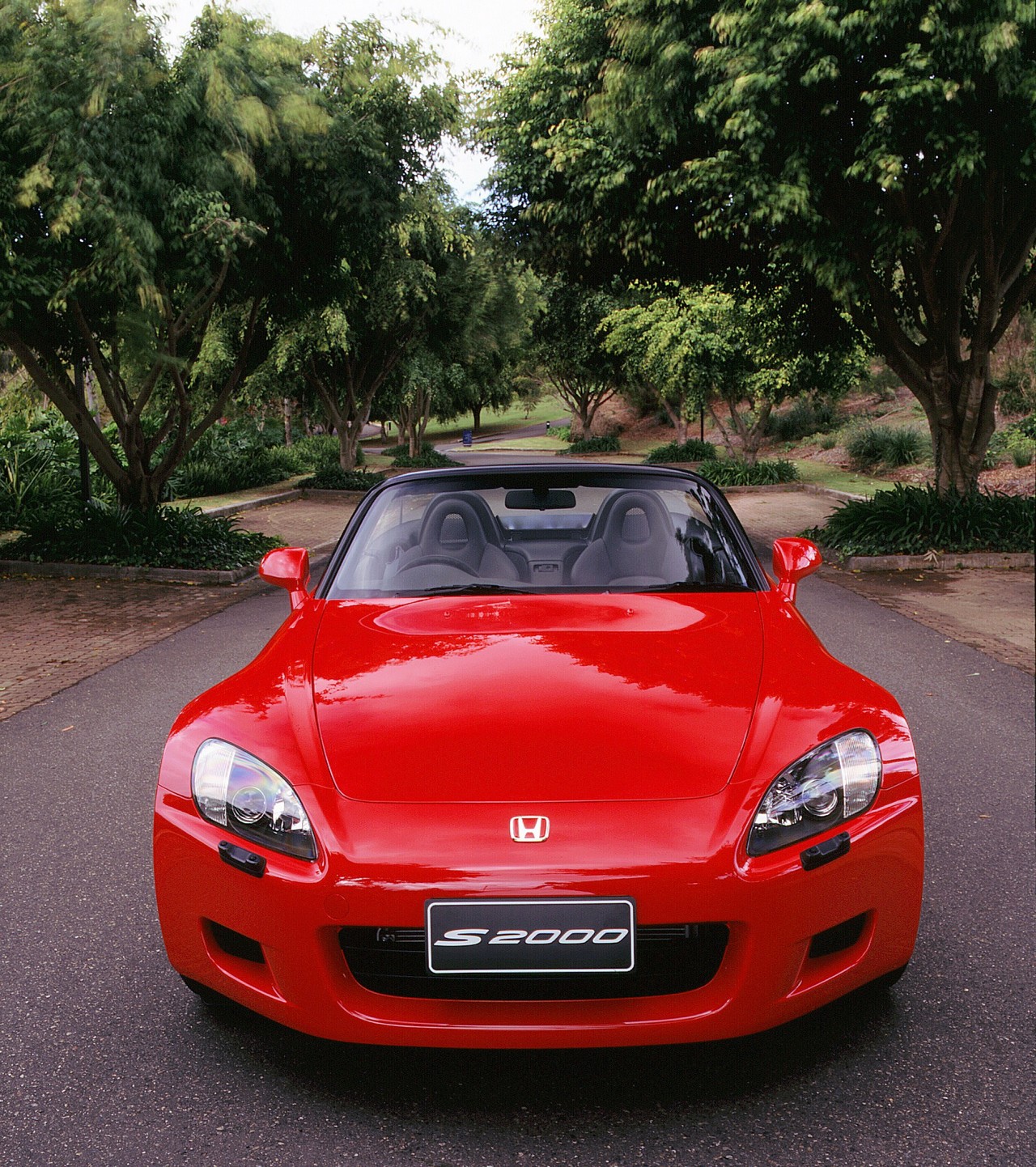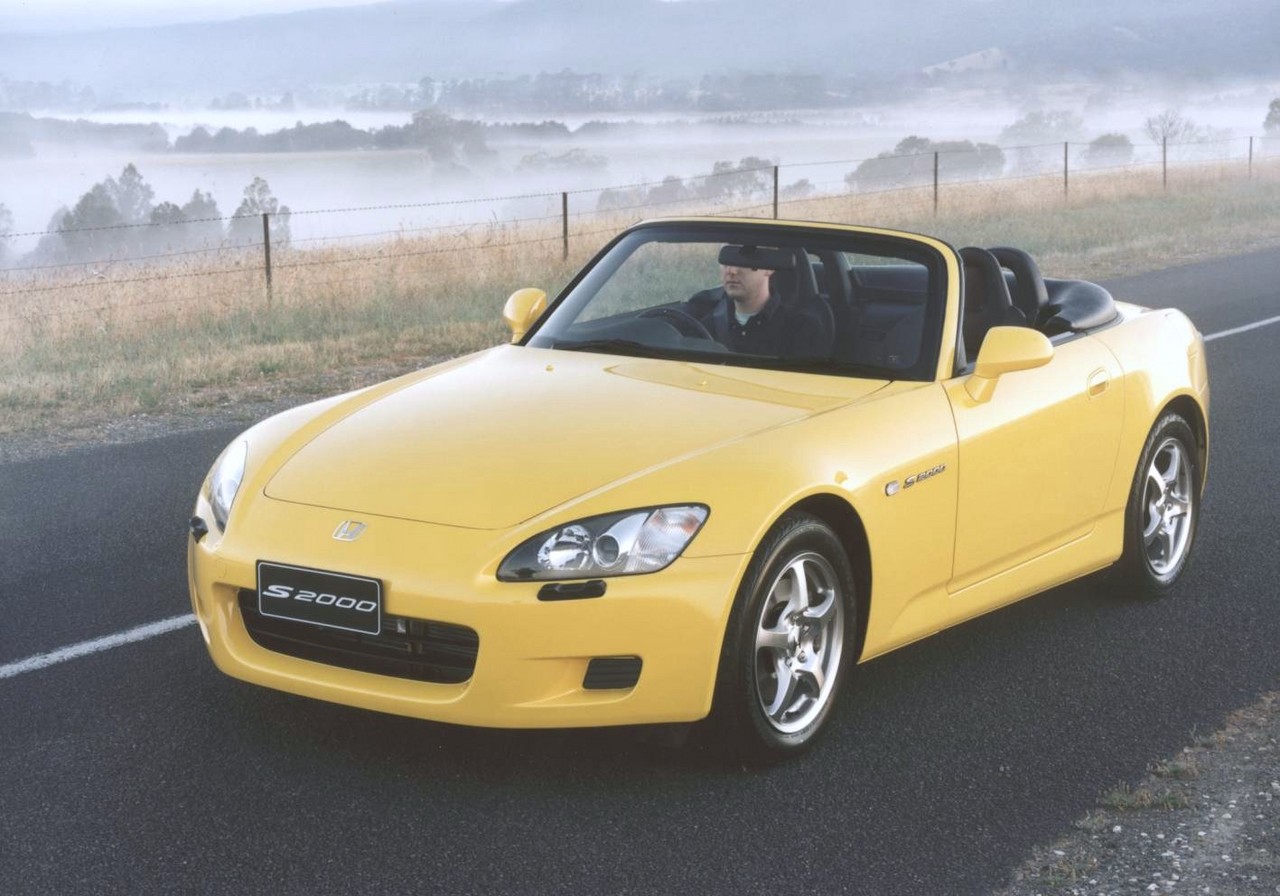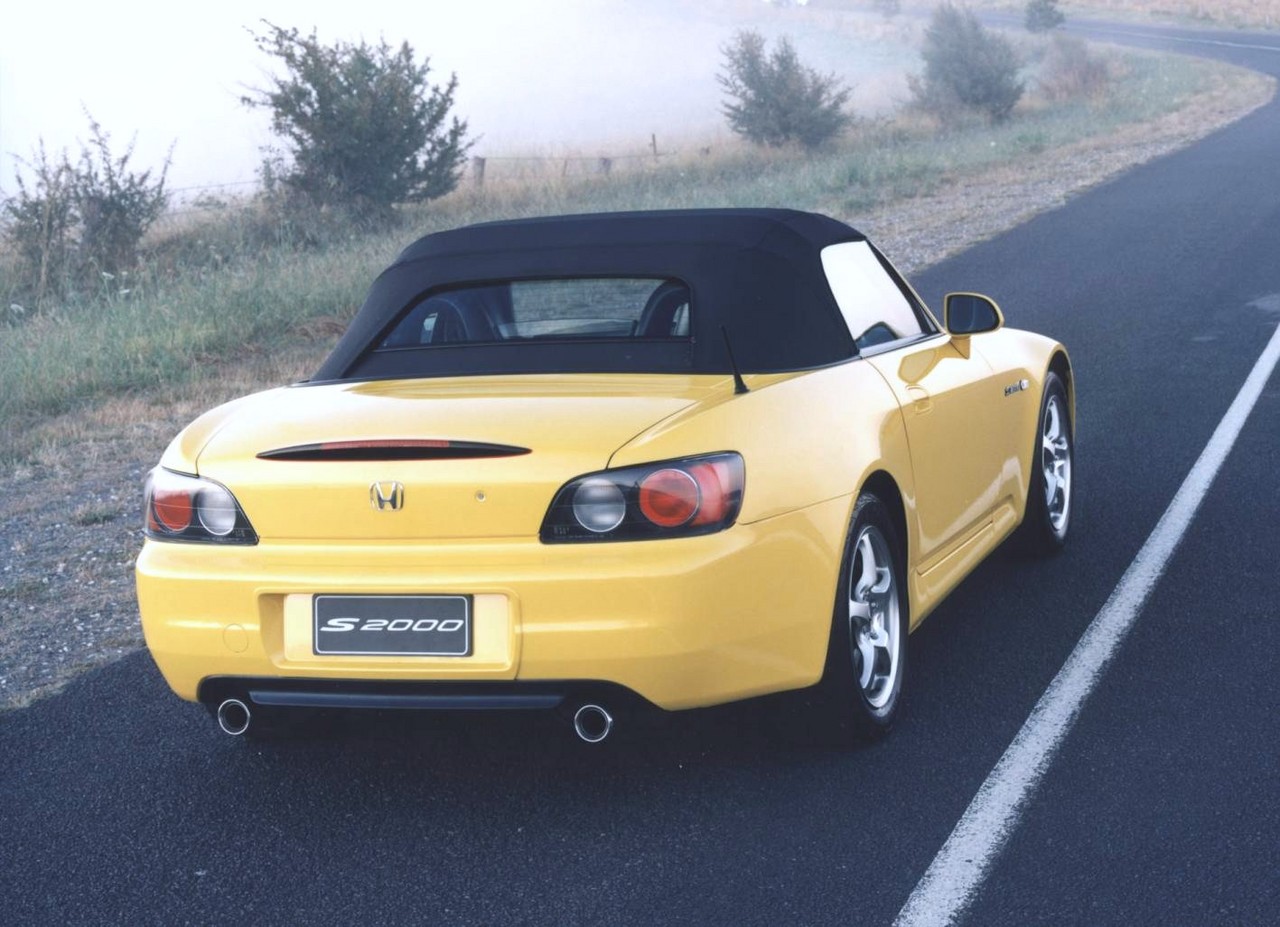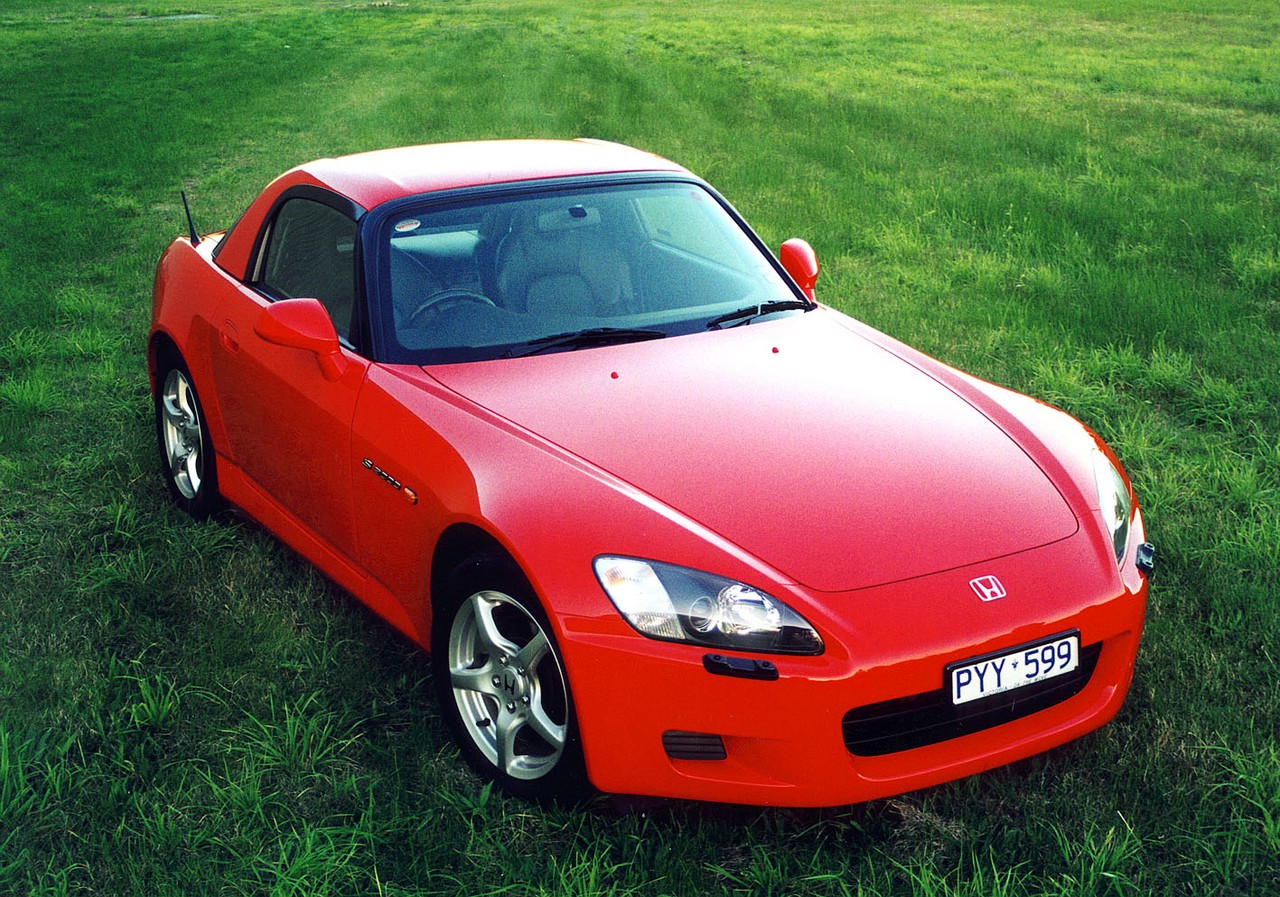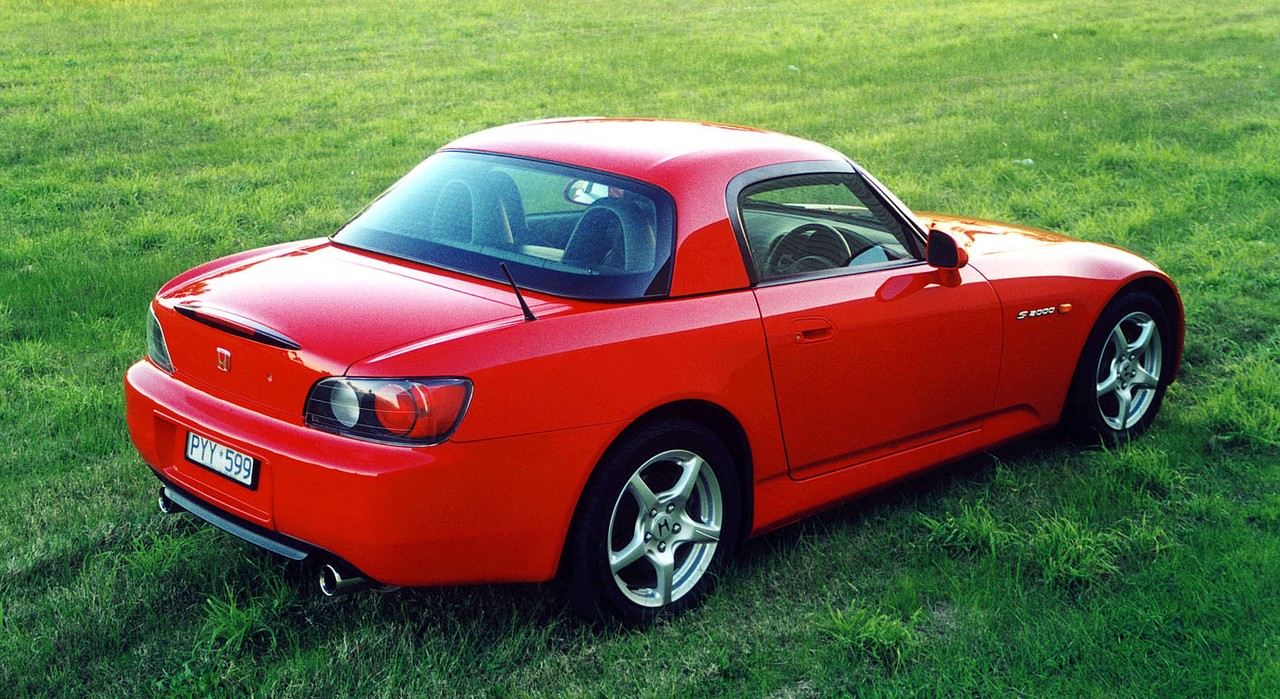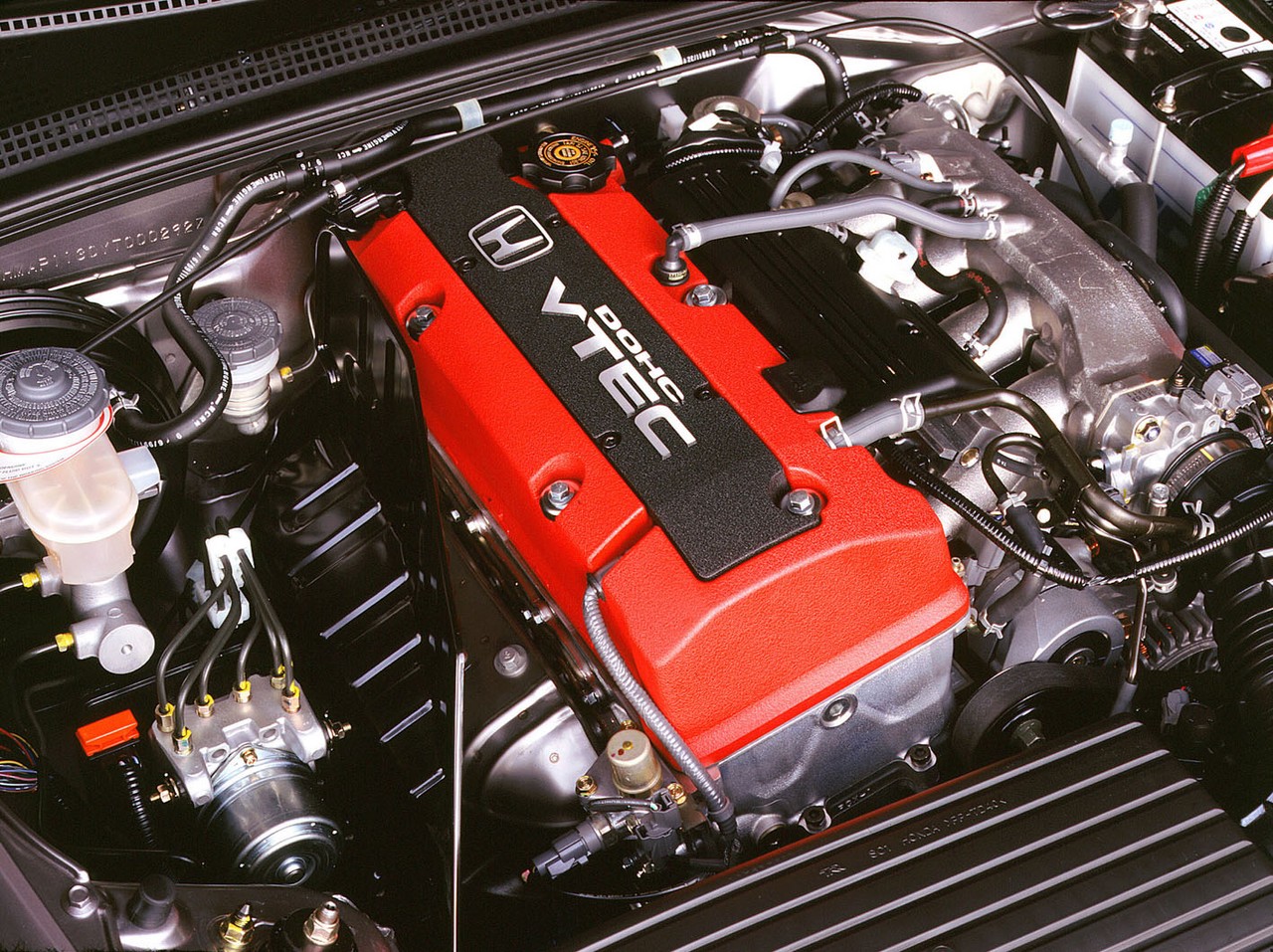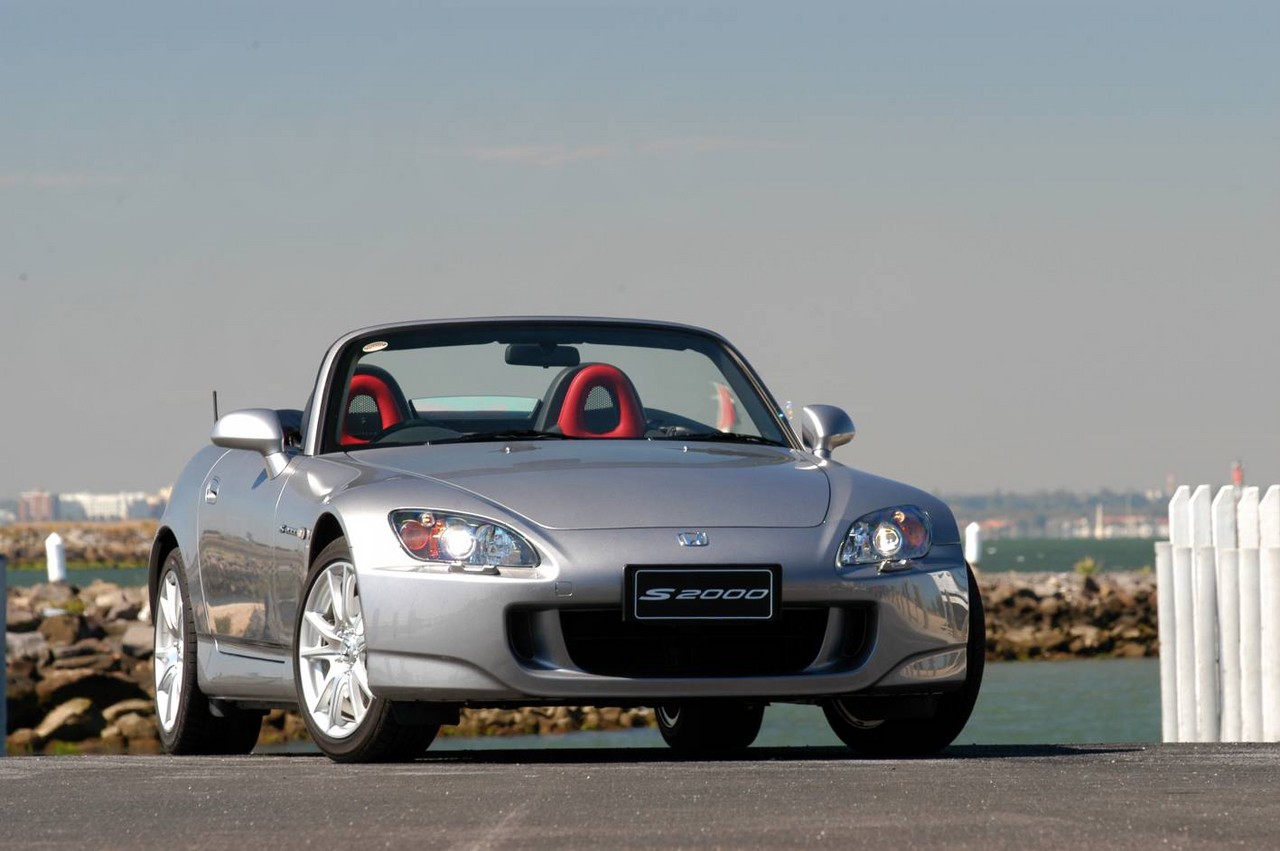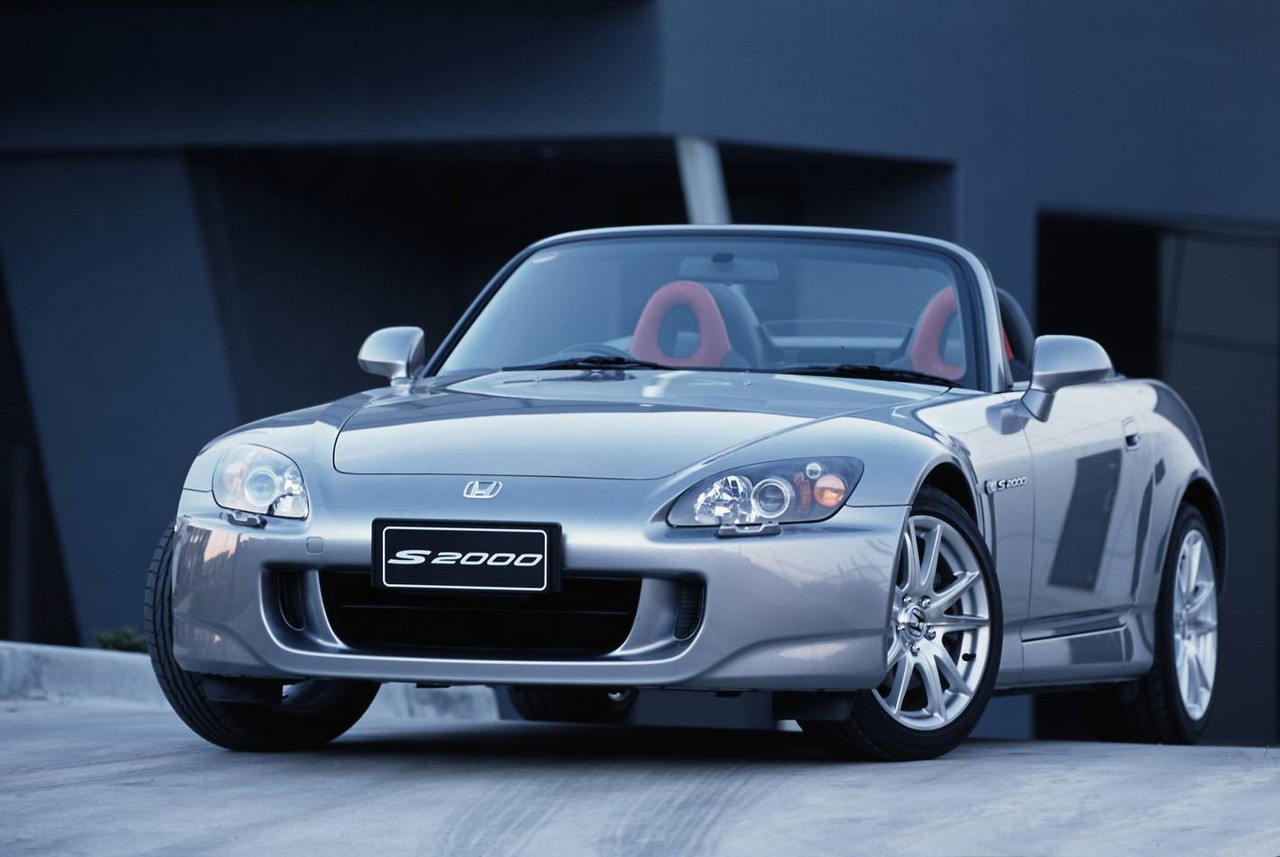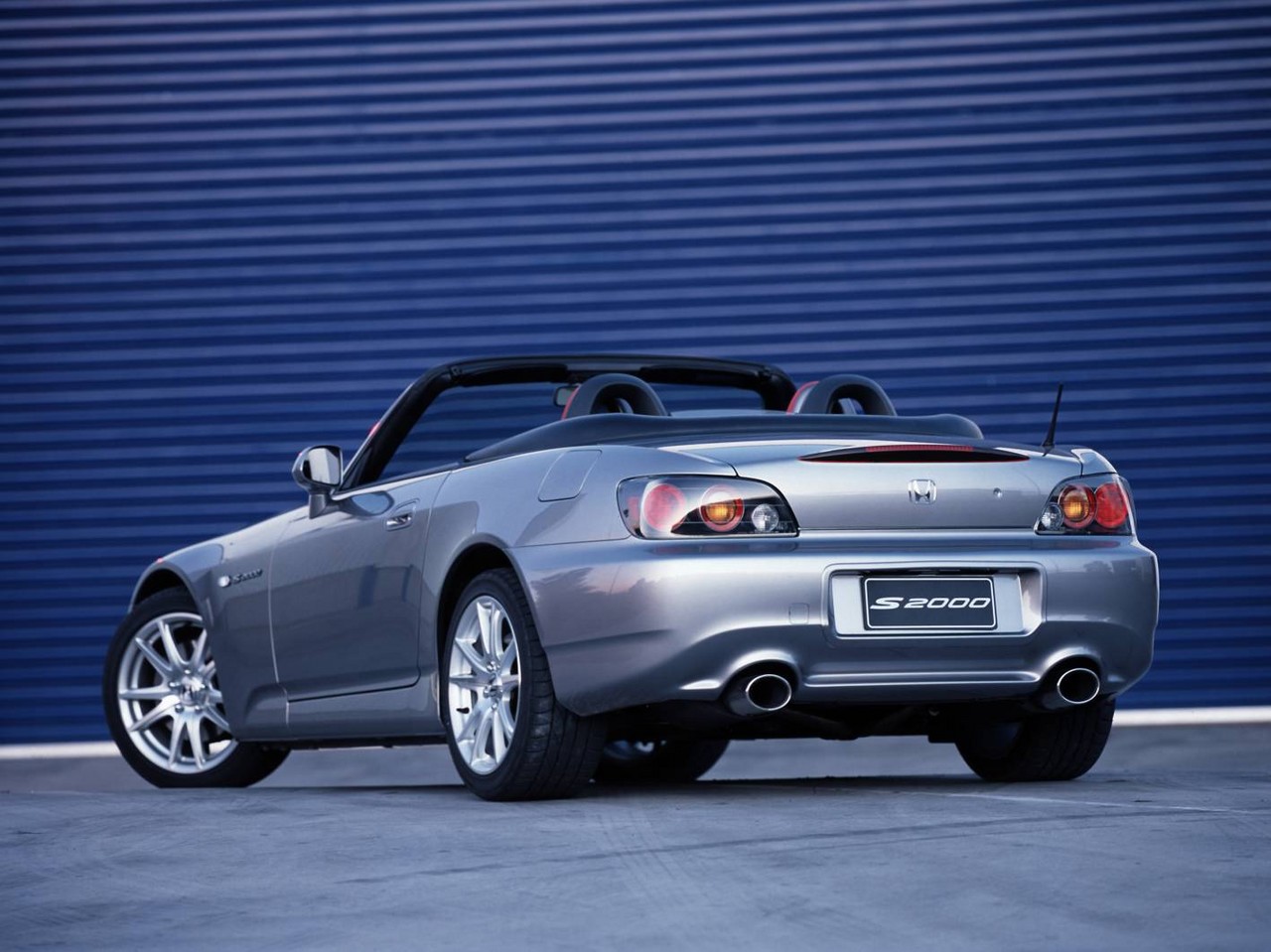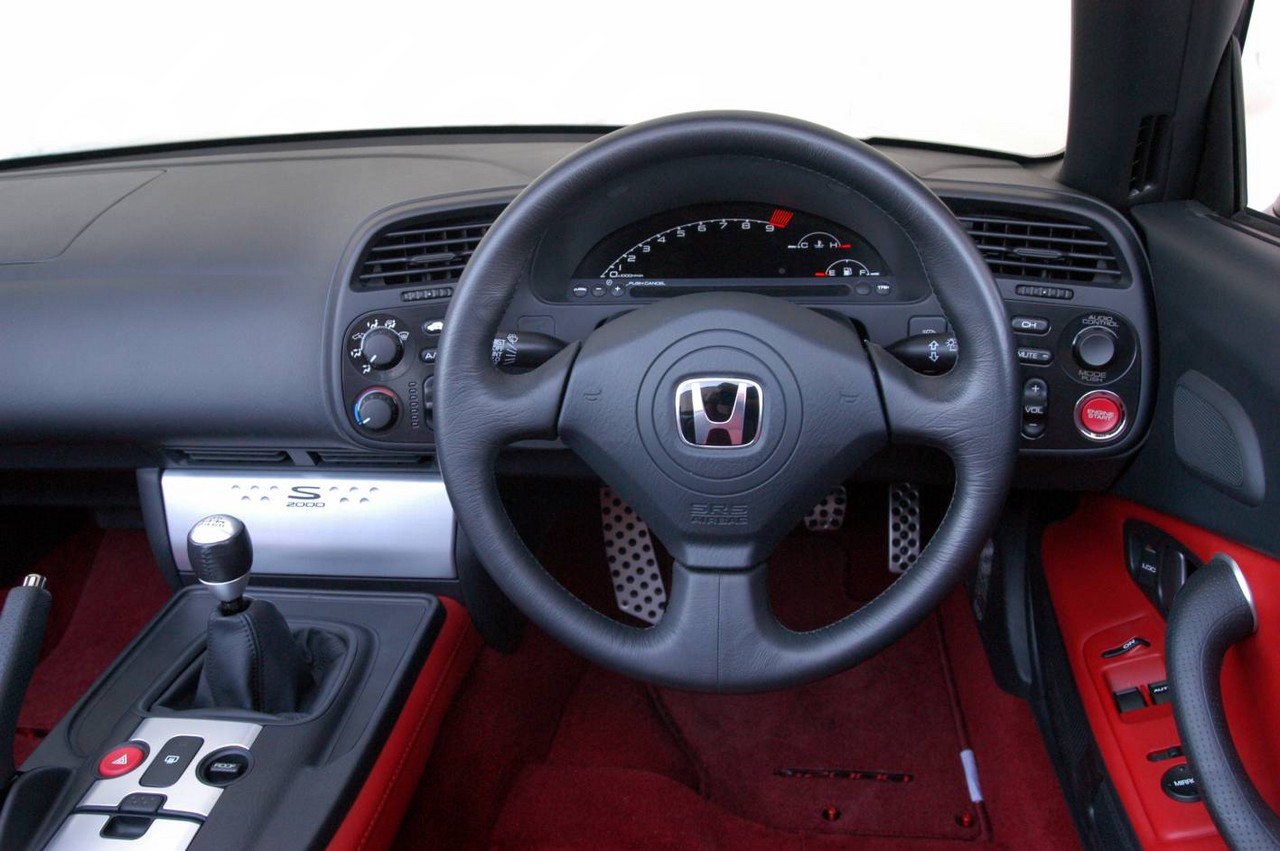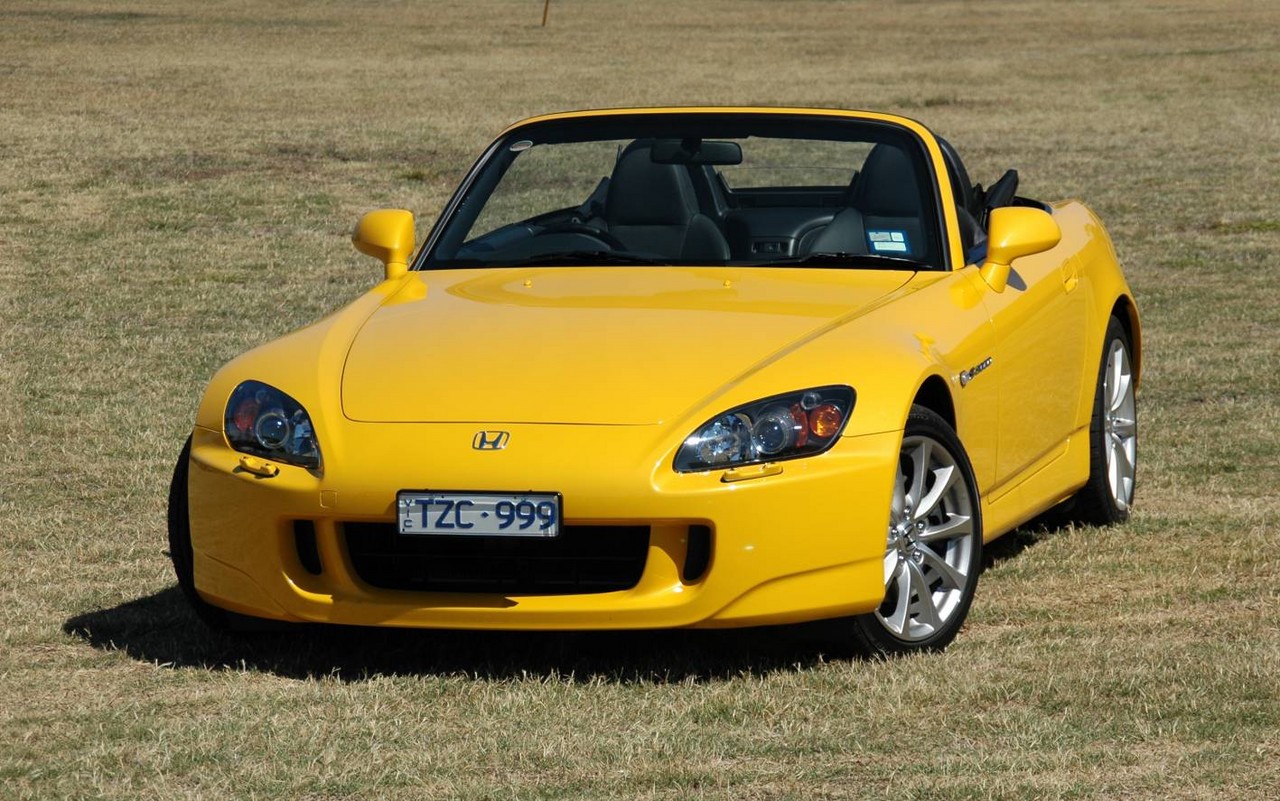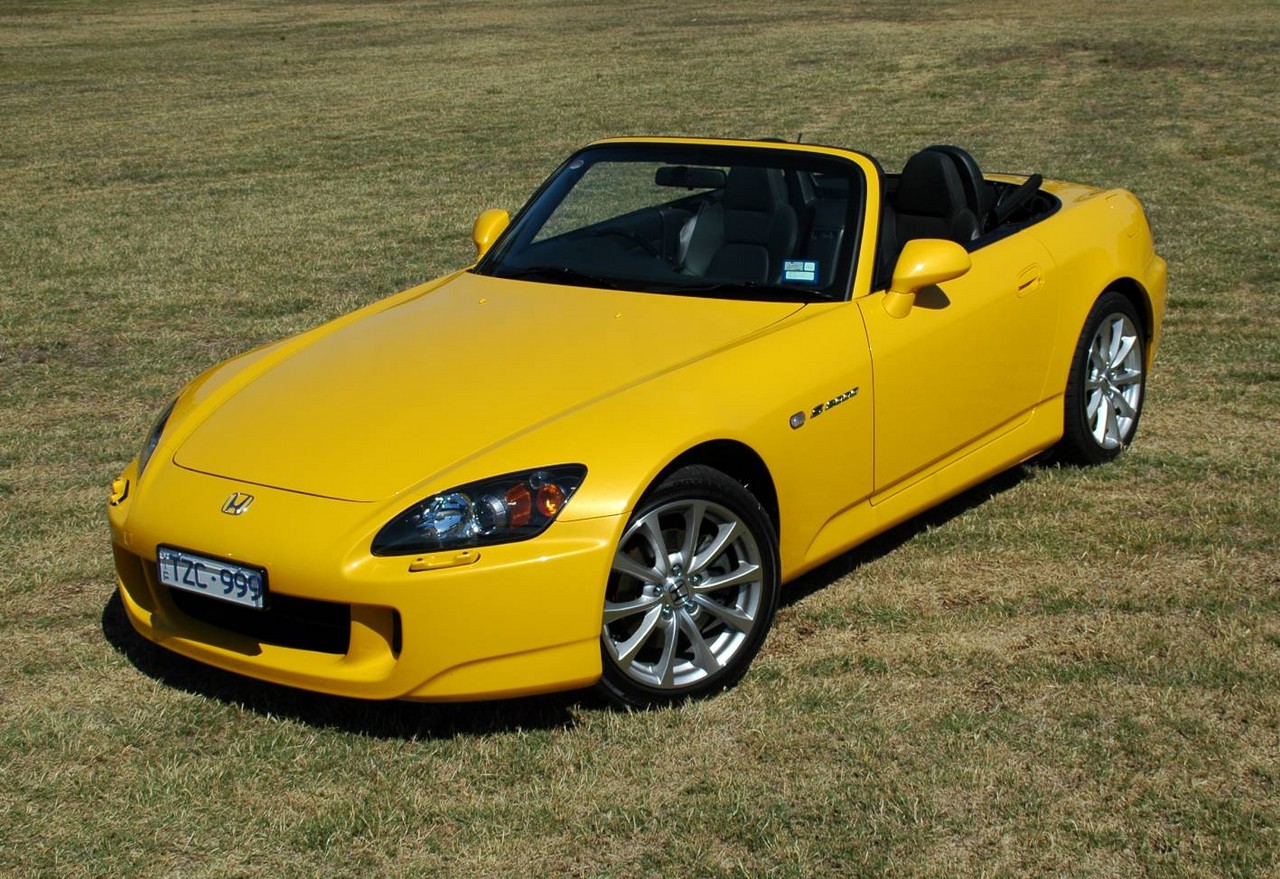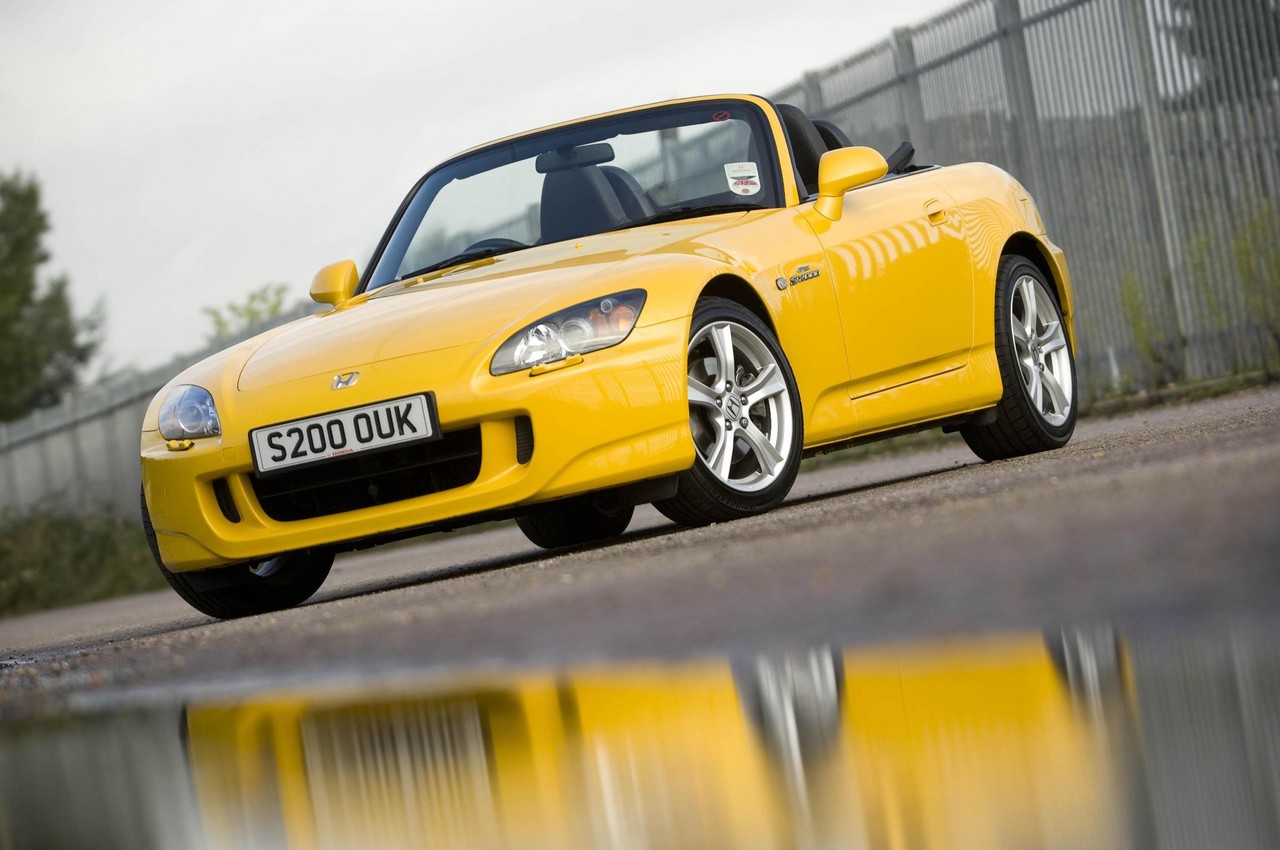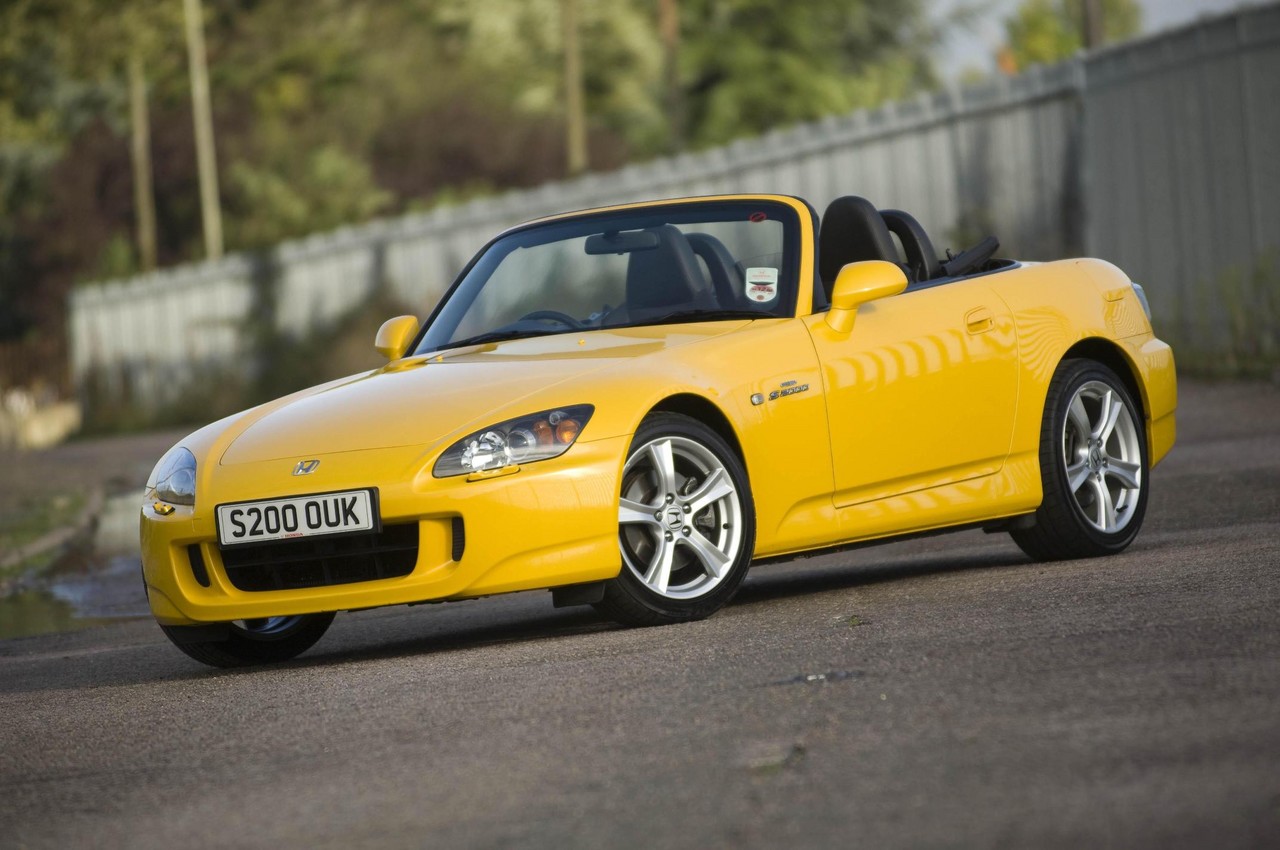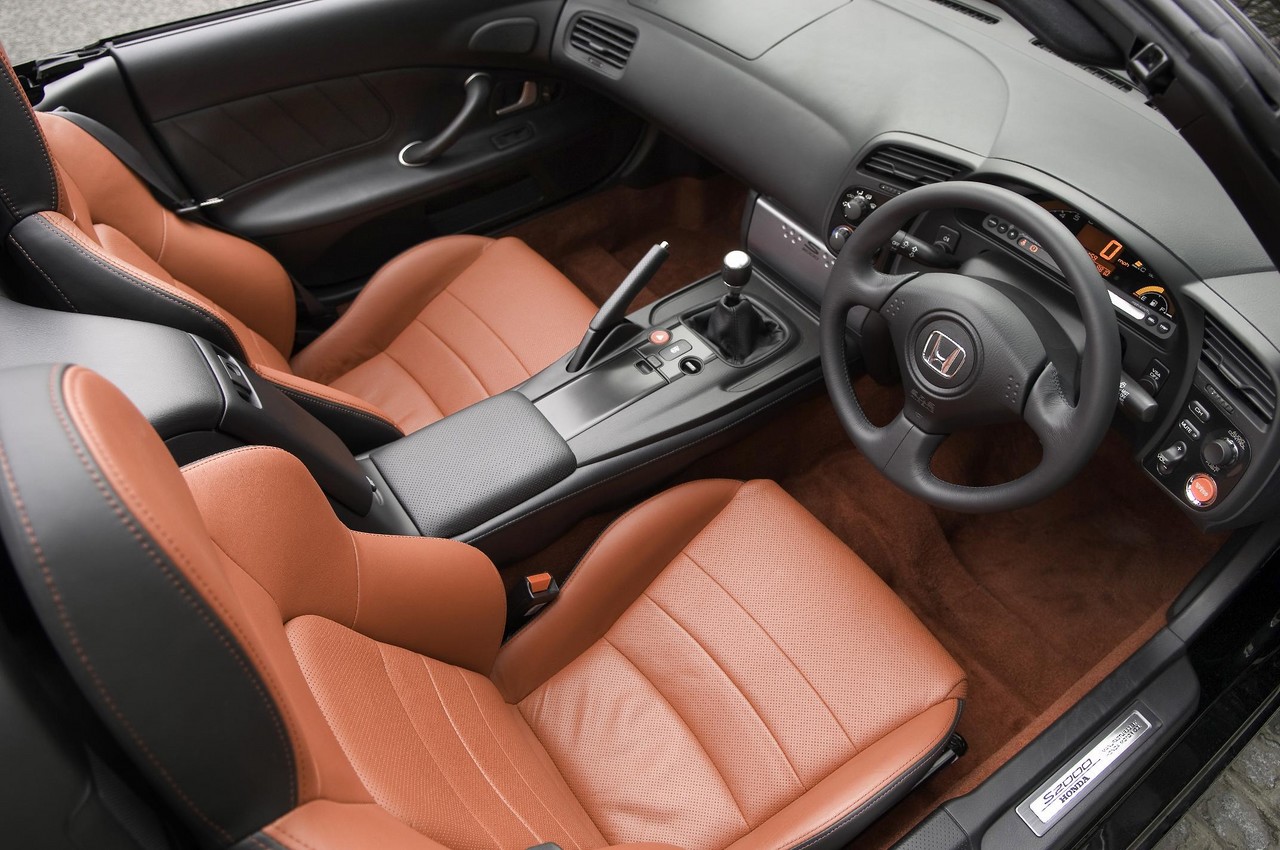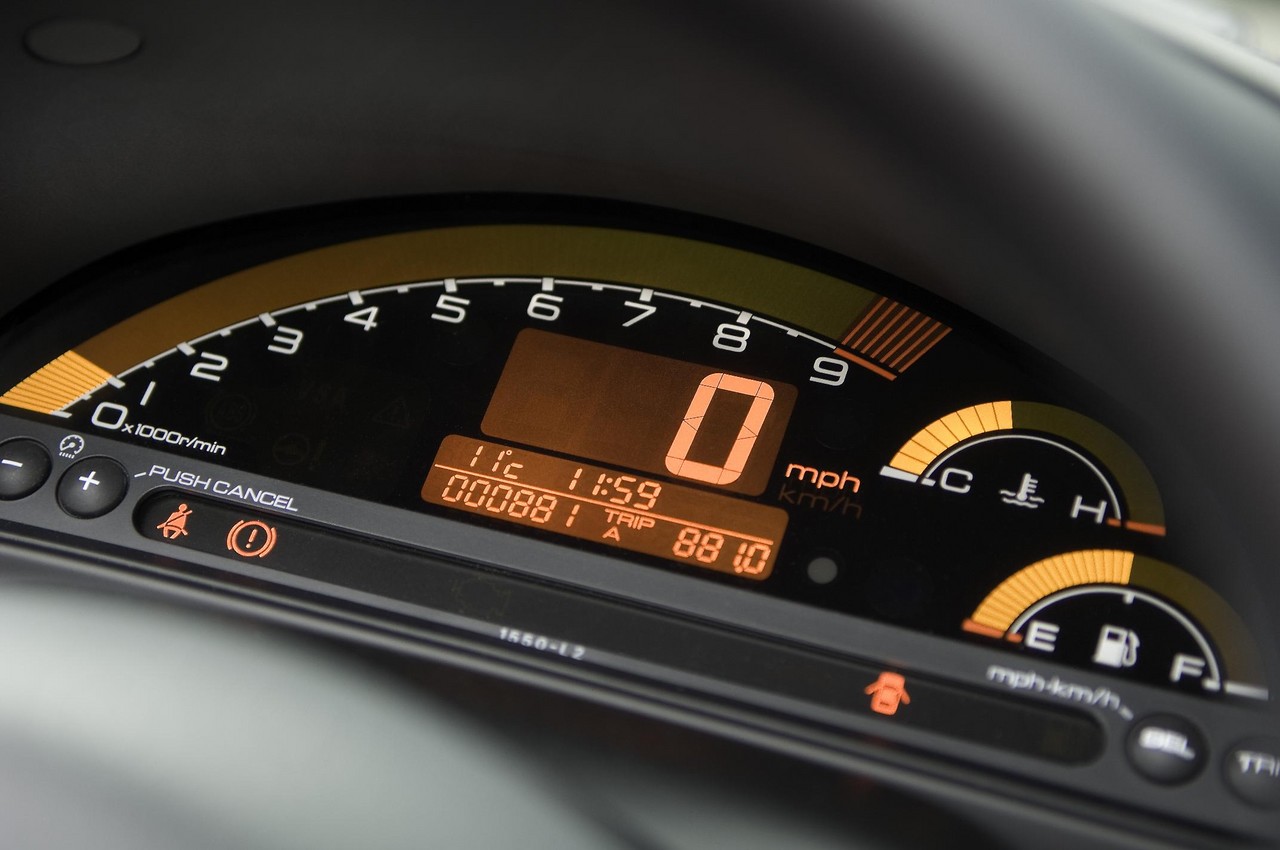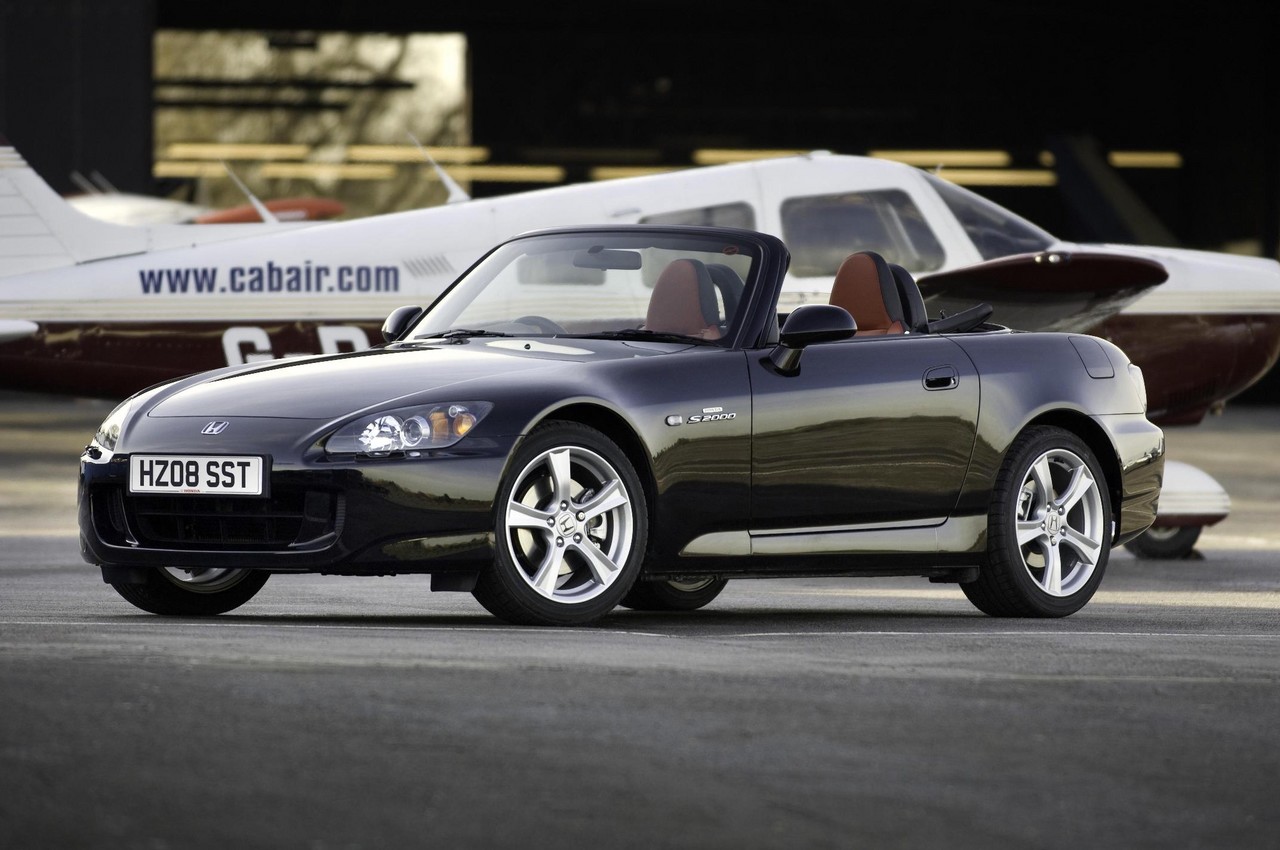
- Free-revving 2.0-litre petrol engine
- Manual transmission provides fast gearshifts and is a joy to use
- Excellent dynamics
- Agile handling
- For AP1.I S2000, steering lacks feel
- Cramped interior
- Suspension lacks compliance
- Engine lacks low- and mid-range response
Honda AP1.I S2000 (1999-04)
Overview
Released in August 1999, the Honda AP1 S2000 was a two-seat convertible with a power-operated soft-top roof. Manufactured in Tochigi, Japan, the rear-wheel drive S2000 was powered by a 2.0-litre F20C four-cylinder petrol engine that was mated to a six-speed manual transmission.
F20C engine
The Honda S2000’s F20C engine had a capacity of 1997 cc, an aluminium alloy block with 87.0 mm bores and an 84.0 mm stroke, fibre reinforced metal (FRM) cylinder liners, an aluminium alloy cylinder head, double overhead camshafts (driven by a chain and scissors gear), fibre-reinforced metal cylinder liners, forged steel connecting rods, forged aluminium pistons, molybdenum disulfide-coated piston skirts for reduced friction, four valves per cylinder actuated by roller-type rocker arms, coil-on-plug ignition and a compression ratio of 11.0:1. For valve actuation, the rocker arms were produced by a metal injection moulding process which Honda claimed to be a world first. Maximum engine speed for the F20C engine was 9000 rpm.
The F20C engine featured Honda’s VTEC (Variable Valve Timing and Lift Electronic Control) system. For each pair of inlet valves and exhaust valves, there were three rocker arms and three corresponding lobes on the camshaft. From idle to 5850 rpm, the valves were operated by the two outboard cam lobes which had short duration and low lift. Beyond 5850 rpm, pins in the rocker arms would lock the two outboard rockers to the centre one which was operated by a high-lift, long duration cam lobe.
The Honda S2000 could accelerate from rest to 62 mph in 6.2 seconds. With an output of 120 PS per litre, the F20C engine also set a new record for a mass produced, naturally aspirated engine.
| Engine | Trans. | Peak power | Peak torque | |
|---|---|---|---|---|
| Honda S2000 | 2.0-litre petrol I4 | 6sp man. | 176 kW at 8300 rpm | 208 Nm at 7500 rpm |
Manual transmission
The Honda S2000 had a six-speed, close-ratio manual transmission in which all gears were on two parallel shafts that were coupled at the output end. According to Honda, this design reduced the load on the gear synchronisers by up to 40 per cent and enabled smaller gears to be used. The transmission had double-cone synchronisers for the first, third and fourth gears, and triple-cone synchronisers on second. With its direct-acting rod type mechanism, the shift action was 23 mm in the horizontal plane and 40 mm in the vertical – this enabled ‘wrist-flick’ shifts.
Dimensions and body
The Honda S2000 was 4145 mm long, 1750 mm wide, 1285 mm tall and had a 2400 mm long wheelbase. The S2000 had a ‘high X-bone frame’ in which the frame rails and centre tunnel combined to form a strong body-chassis which Honda claimed provided comparable rigidity to a closed body design. With a kerb mass of 1259 kg, the S2000 also had a 50:50 front:rear weight distribution.
Suspension and steering
The Honda S2000 had independent, front and rear double wishbone suspension and electric power-assisted steering.
Safety equipment
Standard safety equipment for the Honda AP1 S2000 included dual front airbags, ABS, front seatbelts with pretensioners and load limiters and an automatically-deploying pop-up roll bar.
Brakes
The Honda S2000 had 300 mm by 25 mm ventilated front brake discs and 282 mm by 12 mm solid rear discs.
Euro NCAP crash testing
In Euro NCAP crash testing , the S2000 received a four star adult occupant protection rating with a score of 26.88. In the frontal offset crash test, the driver’s legs could sustain serious damage if they struck components such as the shroud screw turrets, mounting bracket and column lock. The driver’s footwell also added to injury risks because of spot weld release and its loss of stability during impact. Based on this testing, ANCAP awarded the S2000 a four star adult occupant protection rating for the Australian market.
Features: Honda S2000
Standard features for the Honda S2000 included 16-inch alloy wheels, a two speaker sound system with a six-stack CD player, climate control air conditioning, leather seats, a leather-wrapped steering wheel, remote central locking, power windows, power mirrors and an immobiliser.
As standard, the S2000 was also fitted with a Torsen limited slip rear differential.
The Honda S2000’s power-operated soft-top roof could fold away in six seconds. From June 2000, however, a light-weight (20 kg) alloy hardtop roof was available as an accessory – the hardtop featured a glass rear window with demister and full interior trim.
2002: Honda S2000 update
The Honda S2000 was updated for 2002 with revised settings for the suspension and engine control unit. Features were also enhanced with two additional tweeter speakers, a 10-disc CD stacker and glass rear window with defroster. Visually, these models could be identified by their polished alloy wheels, updated front and rear bumper bars and chrome taillight surrounds. Inside, there were additional storage nets and silver highlights for the instrument cluster, door handles and surrounds.
Related links
Honda AP1.II S2000 (2004-09)
Overview
Released in March 2004, the Honda AP1 Series II (AP1.II) S2000 introduced a subtle facelift, mechanical updates and additional features. Mechanically, the AP1.II S2000 introduced 17-inch alloy wheels with revised suspension and tuning (discussed further, below). Visually, the AP1.II S2000 could be identified by its new bumpers, headlight assemblies, LED tail-lights, oval-tipped exhausts and wind deflector.
| Engine | Trans. | Peak power | Peak torque | |
|---|---|---|---|---|
| Honda S2000 | 2.0-litre petrol I4 | 6sp man. | 176 kW at 8300 rpm | 208 Nm at 7500 rpm |
Manual transmission
For the Honda AP1.II S2000, the following changes were implemented for the six-speed manual transmission:
- Carbon fibre-type synchromesh components were introduced for all forward gears to provide a ‘smoother, more positive feel’ and to reduce wear. The carbon fibre synchromesh components were also lighter and had a greater capacity;
- A more rigid clutch housing was introduced to reduce noise and vibration;
- A new clutch delay system was introduced for more seamless torque transfer; and,
- The differential casing was strengthened.
Chassis and suspension
For the Honda AP1.II S2000, a new performance strut was fitted between the two ends of the front frame (ahead of the radiator), while additional bracing was applied to the front suspension upper arm brackets, the rear wheel arch/bulkhead area and the front cross member. Furthermore, the following changes were made to the suspension,
- For the front suspension, stiffer springs and dampers;
- For the rear suspension, softer springs and dampers and a thinner anti-roll bar (diameter reduced by 1.8 mm). By reducing toe-in during bump compression and in the neutral wheel position, bump steer was reduced for greater stability and roadholding. Furthermore, the rear roll centre was lowered by 9 mm; and,
- Strengthened upper arm bushes were introduced.
For the AP1.II S2000, new settings were introduced for the electric power steering, the steering gear ratio was 7 per cent slower and a more rigid mounting was introduced for greater precision, feel and response.
2006: Honda S2000 update
From 2006, safety equipment was improved with the introduction of with electronic stability control and traction control (Honda’s ‘Vehicle Stability Assist’). Drive-by-wire throttle control was also introduced, while the interior featured reshaped seats and two additional speakers located in the front seat headrests.
Brochure
Related links
